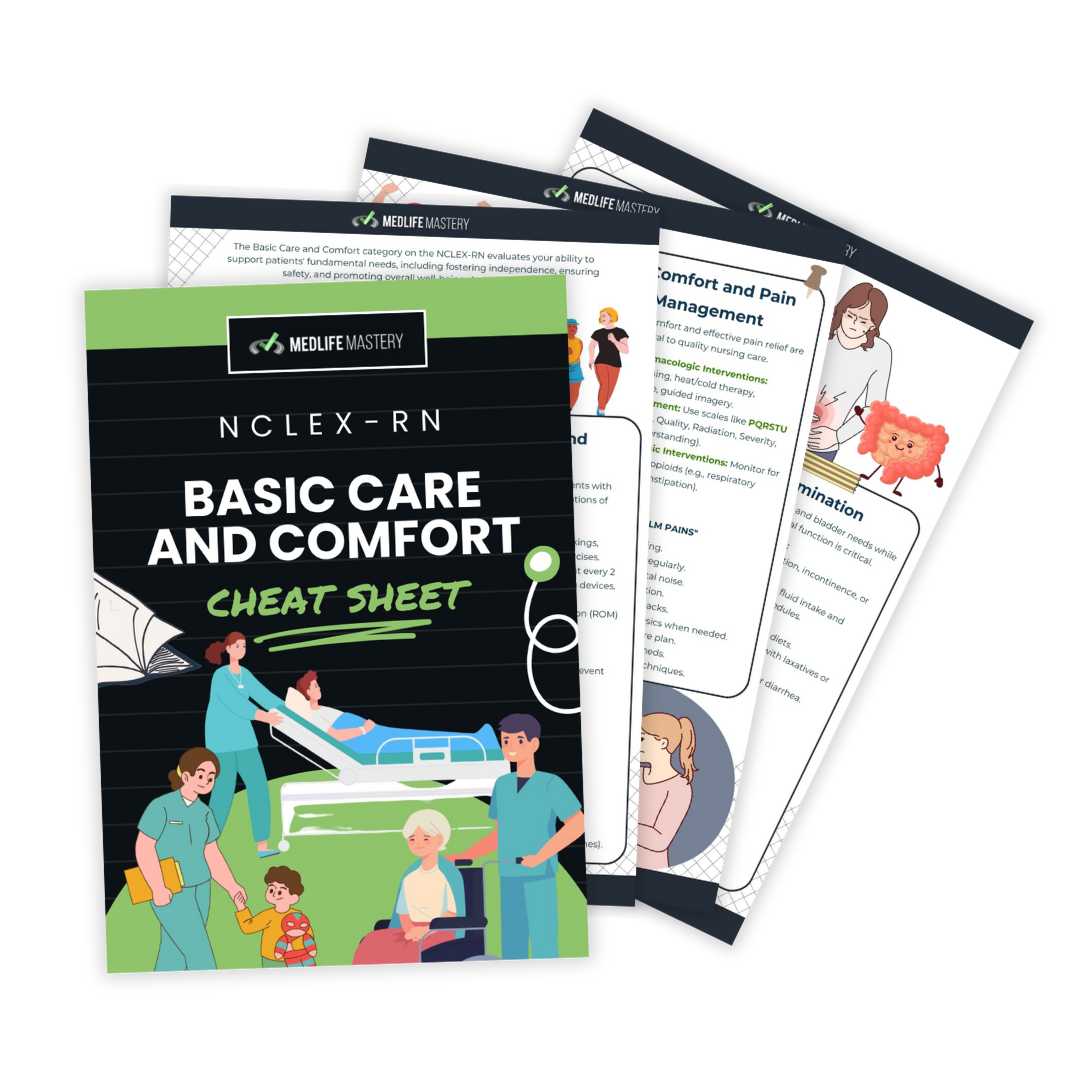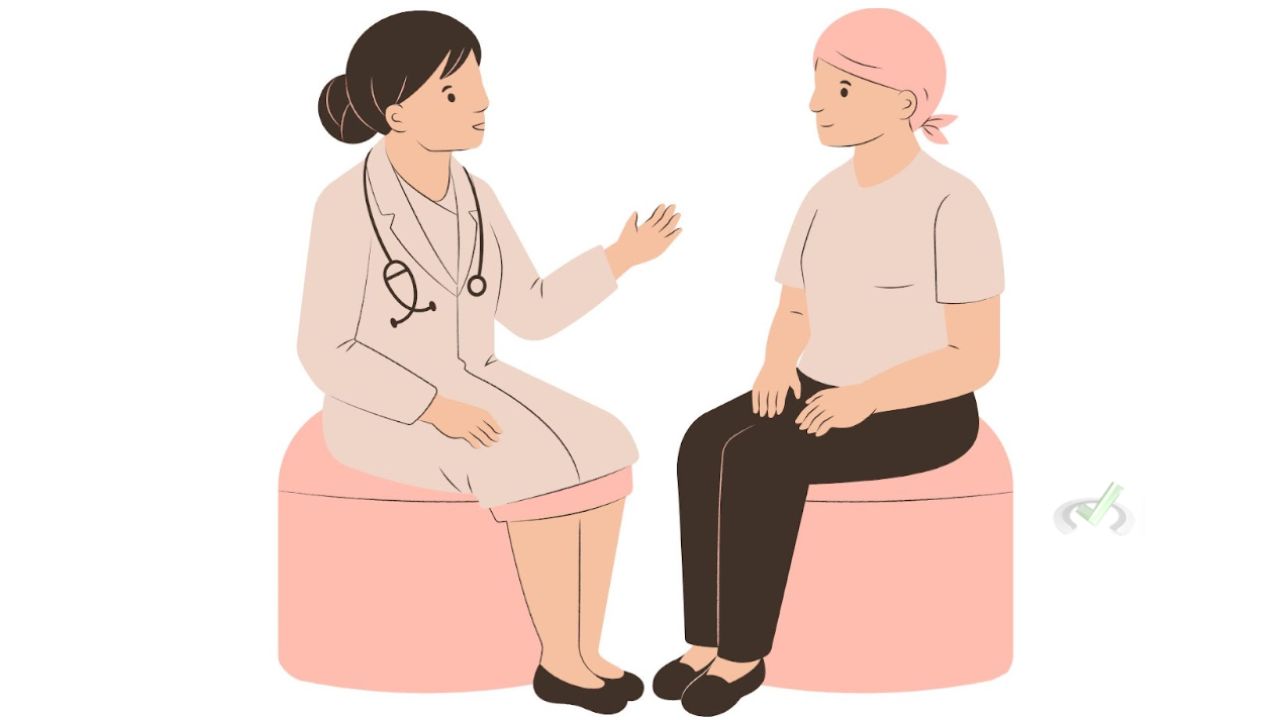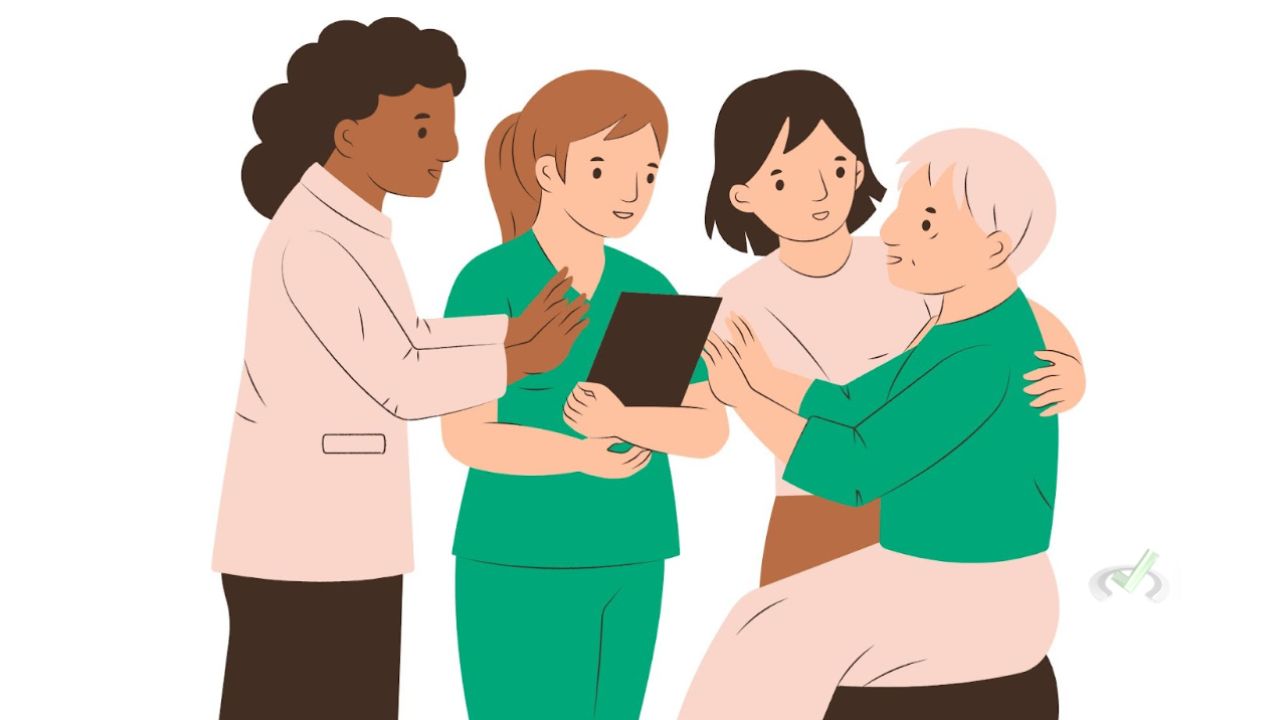Basic Care and Comfort RN Cheat Sheet - Free PDF Download
Over 15% of the NCLEX-RN focuses on basic care and comfort, making it a critical section for anyone preparing for the exam. These aren’t the flashy, high-tech skills you see in movies about hospitals.
They’re the real-life essentials that form the foundation of nursing practice—helping a patient reposition in bed, supporting them through pain, or ensuring they get the nutrition they need to heal.
Why is this section so vital? Because patients rely on these basics every single day, often more than they realize. Think about it: a nurse who can expertly handle IV lines or medications still can’t give proper care without first addressing a patient’s immediate needs for comfort, hygiene, and mobility.
This article will unpack what you need to know about basic care and comfort in NCLEX-RN, complete with study-friendly explanations, practical tips, and plenty of examples to make things stick.
What Does Basic Care and Comfort Cover?
The NCLEX-RN’s basic care and comfort section covers fundamental nursing tasks. These tasks may seem straightforward, but they require careful attention and skill. Let’s face it: turning a patient every two hours to prevent bedsores doesn’t sound complicated until you’re juggling five patients and trying to prioritize care.
That’s why the NCLEX-RN tests not just your knowledge but also your ability to make quick, safe decisions in real-life scenarios.
Here’s what this section includes:
- Mobility: Preventing complications related to immobility, such as pressure sores and blood clots.
- Hygiene: Keeping patients clean and comfortable while preserving their dignity.
- Nutrition and Hydration: Ensuring patients get the nutrients and fluids they need.
- Pain Management: Providing relief through non-pharmacological and pharmacological approaches.
- Elimination Support: Managing urinary and bowel needs, including catheters and ostomies.
- Comfort Care: Addressing emotional, mental, and physical well-being.
We’ll break each of these down so you can understand the concepts, anticipate the questions, and feel ready for whatever the exam throws at you.
Mobility and Immobility: Keeping Patients Moving Safely
Immobility doesn’t just cause discomfort. It creates a cascade of problems that affect the entire body. When a patient can’t move, their muscles weaken, their joints stiffen, and their blood circulation slows.
This increases the risk of conditions like pressure ulcers, deep vein thrombosis (DVT), and pneumonia. Nurses play a critical role in preventing these complications by encouraging safe movement and proper positioning.
Key Concepts
- Range of Motion (ROM):
- Active ROM: Patients pass their own limbs to preserve strength and versatility.
- Passive ROM: Nurses help with movement to reduce stiffness and enhance flow. ROM sports should be done often to avoid contractures and sell blood waft.
- Positioning Techniques: Changing a patient’s role isn’t just about consolation—it’s approximately preventing injury.
- Fowler’s position (semi-upright): Useful for patients with breathing difficulties or feeding needs.
- Lateral position (side-lying): Reduces pressure on the back and prevents bedsores.
- Trendelenburg position: Can help improve circulation when patients feel faint.
- Ambulation Support: Helping patients walk or stand reduces the risks associated with immobility, like blood clots or muscle atrophy. Use gear like gait belts and walkers to make sure stability. Always inspire gradual movement, starting with sitting up before transitioning to standing.
Practical NCLEX-RN Tips:
- Know how to understand early signs and symptoms of immobility complications, like redness on stress factors or swelling inside the legs.
- Understand that lively sporting events should be used instead of passive ROM sporting events.
- Familiarize yourself with positioning techniques and their specific purposes.
Hygiene and Personal Care: Dignity Starts Here
Clean patients feel more comfortable, but hygiene care goes beyond just washing away dirt. It prevents infections, improves self-esteem, and helps patients feel cared for. Hygiene tasks also give nurses the chance to check for skin issues, like pressure sores or rashes, that might otherwise go unnoticed.
Essentials to Remember
- Oral Hygiene: Oral care is critical, especially for patients who can’t perform it themselves. It prevents infections like aspiration pneumonia.
- Use a soft toothbrush to avoid gum injury.
- For unconscious patients, use suction toothbrushes to prevent choking.
- Bed Baths: Bed baths aren’t just about cleanliness. They’re a chance to bond with patients and assess their skin for issues.
- Wash from cleanest to dirtiest areas to avoid spreading germs.
- Keep patients covered with blankets for warmth and modesty.
- Perineal Care: Proper cleaning techniques reduce the risk of infections, especially in patients with catheters or recent surgeries.
- Always clean front-to-back to avoid contamination.
- Use gentle cleansers that won’t irritate sensitive skin.
Practical NCLEX-RN Tips:
- Hygiene-related questions often focus on infection prevention or maintaining patient dignity. Be clear on these principles.
- Know how to handle specific scenarios, like cleaning around a wound or caring for a patient with limited mobility.
Nutrition and Hydration: Fueling Recovery
Nutrition and hydration are the building blocks of healing. Without proper nutrients and fluids, patients can’t recover effectively. Nurses are often responsible for identifying barriers to eating or drinking and finding ways to address them.
Key Points to Review
- Enteral Nutrition (Tube Feeding): Patients who can’t eat orally need alternative methods, like nasogastric (NG) or percutaneous endoscopic gastrostomy (PEG) tubes.
- Verify proper placement to avoid complications like aspiration.
- Monitor for issues, such as abdominal distension or clogged tubes.
- Hydration Assessment: Dehydration can sneak up on patients with constrained mobility or altered intellectual repute. Look for symptoms like dry mucous membranes, decreased urine output, or low blood pressure. Offer fluids or administer IV hydration as wanted.
- Special Diets: Nurses should ensure sufferers get the right vitamins for their condition.
- Low-sodium diets: For patients with hypertension or coronary heart failure.
- Diabetic diets: Help keep solid blood glucose stages.
- Pureed diets: Prevent choking in sufferers with swallowing difficulties.
Practical NCLEX-RN Tips:
- Anticipate questions about recognizing dehydration or providing proper care for sufferers when tube feeding is used
- Know dietary restrictions for common conditions, such as kidney disease or diabetes.
Pain Management: Making Discomfort Bearable
Pain affects every aspect of a patient’s life, from physical mobility to mental health. Managing pain effectively requires a balanced approach that combines medication with non-drug interventions.
Practical Pain Management Strategies
- Non-Pharmacological Interventions: These methods are often a patient’s first line of defense.
- Repositioning alleviates strain on sore muscles or joints.
- Heat or cold packs reduce swelling or tension.
- Distractions, like conversation or music, help redirect focus away from pain.
- Pain Assessment: Patients experience pain differently, so always ask them to describe it. Use scales like zero-10 or visible aids to gauge the severity and manual remedy selections.
Practical NCLEX-RN Tips:
- Expect eventualities that check your capability to prioritize pain control techniques.
- Learn how to tailor interventions based on the patient’s condition and preferences.
Elimination Support: Managing the Body’s Basics
Elimination problems can lead to discomfort, embarrassment, and even serious health risks like infections or bowel obstruction. Nurses play a key role in supporting patients through these challenges.
Focus Areas
- Urinary Elimination: Sterile catheter techniques prevent infections. Encourage fluid intake to reduce the risk of urinary tract infections (UTIs).
- Bowel Regulation: Constipation or diarrhea requires quick action. High-fiber diets and adequate hydration prevent constipation, while stool softeners or enemas provide relief when necessary.
- Ostomy Care: Patients with ostomies need both physical and emotional support. Teach them to clean and empty their ostomy bags properly. Check stoma health regularly, watching for redness or swelling.
Practical NCLEX-RN Tips:
- Be familiar with signs of elimination problems, like distended abdomens or abnormal urine color.
- Questions often test your ability to balance patient comfort with safety.
Comfort Care: Caring for Mind and Body
Comfort care addresses the patient as a whole—mind, body, and spirit. These interventions make patients feel less like cases and more like people.
Techniques to Consider
- Environmental Adjustments: Small adjustments, like dimming lighting or decreasing noise, can beautify patient rest.
- Emotional Support: Listening to them and associated with their households can offer a lot of wanted reassurance.
Practical NCLEX-RN Tips:
- Comfort care questions frequently require balancing scientific desires with emotional well-being. Always bear in mind everything.
Mental Health Support: The Often Overlooked Aspect of Basic Care and Comfort
Mental fitness is as crucial as physical fitness, and addressing it can remodel an affected person’s restoration adventure. Stress, anxiety, and depression often accompany illness, surgical treatment, or hospital stays. Ignoring those emotional needs can decrease patients’ quality of life.
Nurses are uniquely positioned to provide emotional support while addressing physical care, making mental health a vital part of basic care and comfort in NCLEX-RN. Mental health support doesn’t mean counseling or therapy—those tasks belong to specialized professionals.
Instead, it involves fostering a calm, supportive environment and recognizing when a patient needs additional help.
Methodical Strategies to Promote Mental Health
- Establishing a Trusting Environment: Hospital stays frequently make patients feel exposed. Be kind and respectful to them to earn their trust. When they speak, pay attention and keep your eyes open. Talking quickly is never appropriate; patients need to feel heard.
- Identifying Distress Signs: Patients may not always express their difficulties verbally. Keep an eye out for nonverbal indicators such as sighing frequently appetite loss or withdrawn behavior. These symptoms could be a sign of stress, anxiety or depression.
- Encouraging Relaxation: Little adjustments can have a significant impact. Provide calming activities like reading materials or relaxing music or change the lighting in the room to lessen harsh glare. Patients should be encouraged to voice any concerns or anxieties they may have without worrying about being judged.
- Promoting Family Involvement: Family visits frequently help patients feel less stressed. Include family members in care plans when appropriate. They can provide support and assurance that even the most skilled nurse cannot match.
- Teaching Stress-Reduction Techniques: Simple breathing exercises or mindfulness practices can empower patients to take control of their anxiety. Nurses can guide patients through short exercises to help them relax, even in stressful medical settings.
Mental Health Support in NCLEX-RN Scenarios
The NCLEX-RN frequently tests how well nurses recognize emotional needs. For example, you may be asked how to handle a patient feeling overtaken by a diagnosis. In these situations, active listening, empathy, or, if required, seeking counseling is frequently the right answer.
Why This Matters for Your Practice
Mental health care is more than just a box to check. It’s a way to connect with patients as people and provide holistic care. By addressing emotional and physical needs together, nurses build trust, reduce stress, and contribute to faster recovery.
For the NCLEX-RN, understanding these principles will help you handle questions about patient-centered care with confidence. In real-life nursing, it will help you provide care that truly makes a difference.
NCLEX-RN Tips: Acing Basic Care and Comfort Questions
- Focus on safety first. If a question involves preventing harm, that’s your priority.
- Use Maslow’s hierarchy to guide your decisions. Physical needs like breathing or hydration always come before psychological needs.
- Think through scenarios practically, not just theoretically.
Conclusion: Basic Care and Comfort in NCLEX-RN is the Foundation of Great Nursing
Basic care and comfort in NCLEX-RN doesn’t test obscure skills or complicated procedures. It focuses on the fundamentals—the small, everyday tasks that form the heart of nursing. These are the moments where nurses make the biggest difference, not just in exams but in patients’ lives.
Master these concepts, and you’ll walk into the NCLEX-RN prepared and confident. More importantly, you’ll leave the exam ready to deliver thoughtful, compassionate care to those who need it most.






